Did you know birds can smell things 100 times better than humans? This is why some smells can keep birds away. You can use essential oils or spicy smells to keep birds from unwanted places.
In this guide, we’ll look at the best ways to keep birds away. We’ll focus on methods that use a bird’s senses. This includes pigeons, seagulls, and other birds that bother us. Learning how to use their natural dislikes can help keep your area bird-free.
Key Takeaways
- Birds have a highly sensitive sense of smell that can be leveraged to deter them from specific areas.
- Essential oils, spicy solutions, and strong-scented herbs are effective natural bird repellents.
- Professional bird deterrent products, physical barriers, and environmental modifications can also be utilized.
- It’s important to consider legal and humane approaches when implementing bird control methods.
- Combining multiple deterrent strategies can provide the most comprehensive and long-lasting solution.
Understanding Bird Behavior and Sensory Perception
Many people think birds don’t have a good sense of smell. But research shows pigeons can smell scents and their heart rates go up. Seabirds can even smell krill-eating phytoplankton, helping them find food.
How Birds Process Smells and Scents
Birds are drawn to their own droppings and nesting areas. This is because of pheromones. They also follow food smells, especially those that signal food or prey.
Natural Bird Instincts and Aversions
Birds see much better than humans. Eagles, hawks, and owls can spot things from far away. A starling’s eye is huge compared to its head, helping it see clearly.
- Some hawks have more cones in their eyes than humans, making their color vision better.
- Barn owls can find prey by sound from far away.
- Turkey vultures can smell decaying tissue from a distance.
Birds can taste salty or bitter foods and see ultraviolet light. Their eyes are the biggest compared to their body size. This lets them see things humans can’t.
Birds’ amazing senses help in bird-proofing and bird control methods. Knowing how they perceive the world is key to stopping them.
What Do Birds Not Like: Natural Deterrent Methods
Using natural methods to keep birds away is very effective. These methods use the birds’ own senses against them. This makes the area less appealing, causing birds to look elsewhere.
Citrus scents, like lemon, are a big turnoff for birds. So are the smells of garlic, onions, and chili peppers. These smells are great at keeping birds away.
Vinegar, cinnamon, and mint also work well. Their strong smells overwhelm birds, making them leave the area.
- Lemon and other citrus scents
- Garlic, onions, and chili peppers
- Vinegar, cinnamon, and mint
Visual cues can also scare birds. Shiny objects, like aluminum foil, bother their eyes. Predator decoys, like plastic owls, also scare them away.
| Natural Deterrent | Effect on Birds |
|---|---|
| Citrus Scents | Overwhelming and unpleasant odor |
| Garlic, Onions, Chili Peppers | Spicy, irritating smells |
| Vinegar, Cinnamon, Mint | Strong, pungent aromas |
| Shiny Objects | Bother birds’ sensitive eyes |
| Predator Decoys | Scare birds away from targeted areas |
Using these natural deterrents helps keep birds away. It’s a kind way to protect your space without using harsh chemicals.
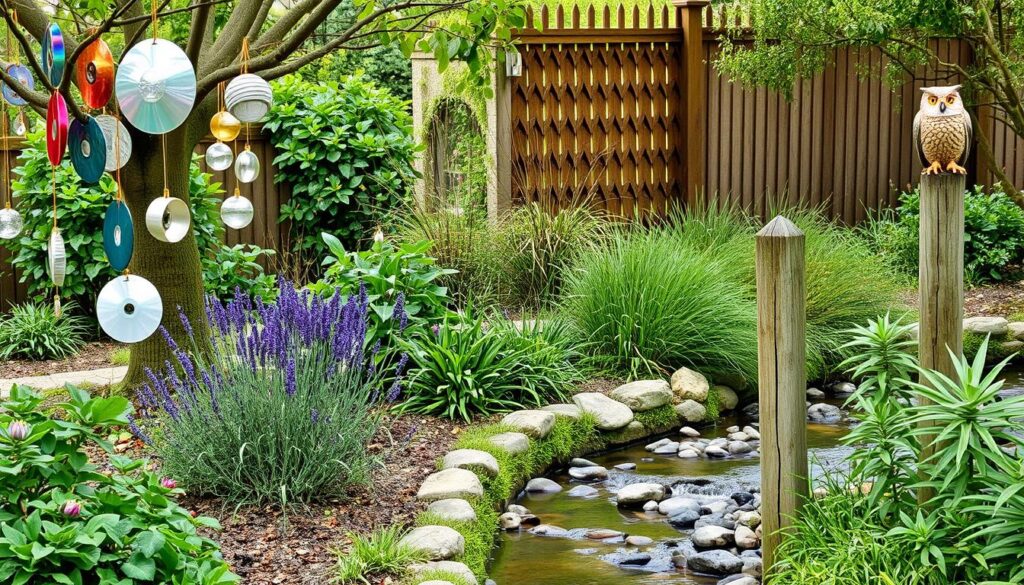
Essential Oils as Bird Repellents
Essential oils are a natural way to keep birds away. Peppermint oil and citrus oils are especially good at this. They can chase away birds from your yard.
Peppermint Oil Solutions
Peppermint oil is great for homemade bird sprays. Mix 14 drops of peppermint oil, 14 drops of lemon oil, 1/2 cup of white vinegar, and 1/2 cup of water in a spray bottle. Spray it where birds are a problem.
You can also use cotton balls soaked in peppermint oil. Place them around your space to keep birds away.
Citrus Oil Applications
Citrus oils like lemon, orange, or grapefruit work well too. But, they need to touch the birds to work. Use citrus oil sprays or peels in problem spots to keep birds away.
Best Essential Oil Combinations
For better results, mix different essential oils. A blend of 10 drops each of peppermint and citronella oil in 500 ml of water is very effective. Try different mixes to find what works best for you.
“Essential oils, especially peppermint and citrus, are a natural way to keep birds away. The right mix and use can make your space bird-free.”
Spicy Deterrents: Using Pepper-Based Solutions
Spicy, pepper-based solutions can keep unwanted birds away. They use capsaicin, the heat in chili peppers, to repel birds. This method is safe for birds and doesn’t harm them.
A simple recipe is a cayenne pepper spray. Mix 6 drops of dish soap, 2 tablespoons of cayenne pepper, and 1 gallon of water. Spray it on areas where birds shouldn’t be. You can also use chili powder mixed with water.
These solutions irritate birds’ senses, like their eyes and throat. But they don’t harm birds or damage plants. Research shows capsaicin doesn’t hurt birds’ mouths, eyes, or stomachs. This makes them a kind way to keep birds away.
Keep in mind, these sprays might need to be reapplied often. This is especially true after rain or strong winds. For bigger problems, you might need stronger products with capsaicin.
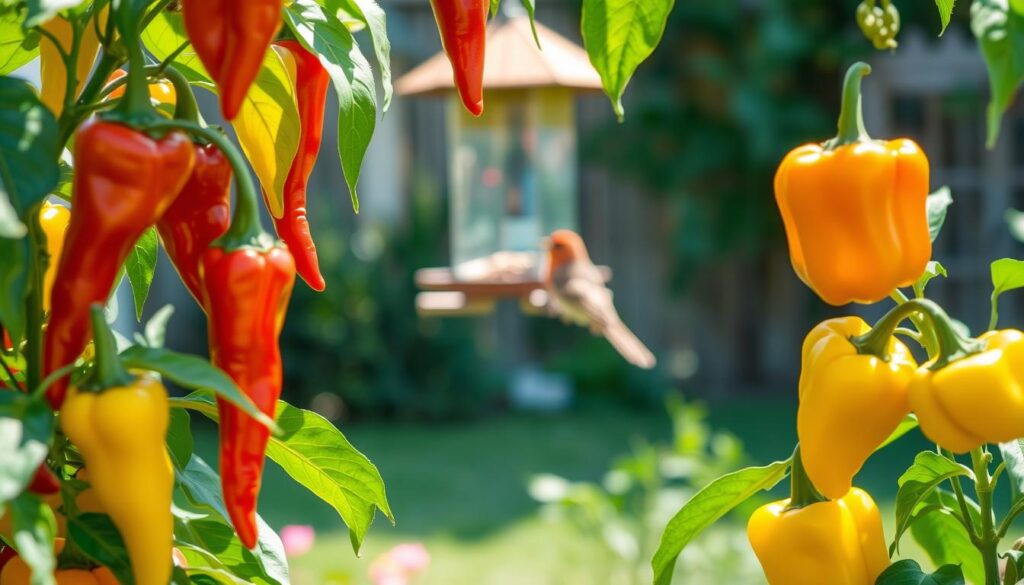
Knowing how birds react to spicy things helps keep them away. This natural method is great for keeping your place bird-free. It’s a smart way to protect your property without harming birds.
Garlic and Strong-Scented Herbs as Deterrents
Garlic and strong-scented herbs are great for keeping birds away. They make birds feel uncomfortable, which keeps them from coming back. This is a natural way to control bird populations.
Creating Garlic-Based Sprays
To make a garlic spray, mix 8 cloves of garlic with 2 cups of olive oil. Spray this on places where birds like to hang out, like gutters and roofs. Adding onions to the mix makes it even stronger.
Herb Combinations for Maximum Effect
- Mint: The cool, refreshing scent of mint is an excellent natural bird deterrent.
- Cinnamon: Birds don’t like the sweet, spicy smell of cinnamon. It’s great for keeping them away.
- Citronella: This comes from lemongrass and has a strong citrus smell. It’s known to keep birds away.
Using these herbs together makes a strong bird-proofing solution. It’s good for the environment and safe for your property. Remember to reapply these bird control methods every few days, especially after it rains.
“Garlic oil is proven to be effective in agricultural fields for higher crop yields, and is recommended by organic farm regulatory organizations for its non-toxic and safe qualities.”
Vinegar-Based Bird Repellent Solutions
Keeping birds away from your property can be tough. But vinegar is a powerful tool. Its strong smell can bother birds and keep them from coming back. Apple cider vinegar is especially good at keeping birds away.
But vinegar can harm plants. So, use it where plants aren’t a problem. Like on porches, garages, or other places birds like to hang out.
To make a bird repellent spray, mix equal parts white vinegar and water. Spray it where birds are a problem. This natural solution is cheap and works well. Just remember to spray it often, as the smell fades.
| Bird Species | Number of Smell Receptors |
|---|---|
| Turkey Vultures | Approximately 1,300 |
| Owls | Can detect odors up to 1 million times lower than humans |
| Pigeons | Around 800 |
| Chickens | Around 200 |
Research shows that baby chicks are scared of vinegar fumes. This proves vinegar is a great way to keep birds away. Adding vinegar to your bird control plan can help keep your property bird-free.
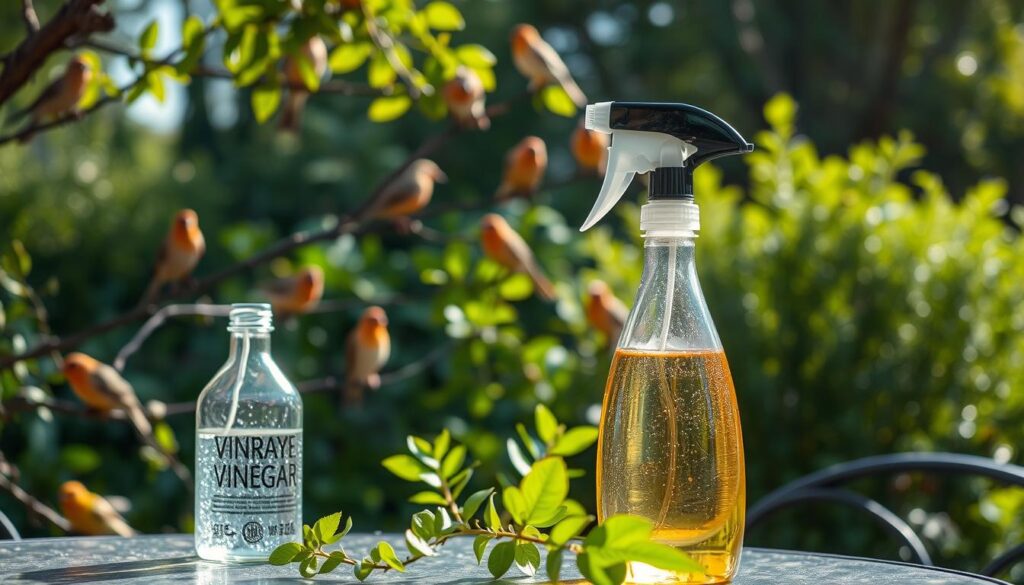
“At Bird B Gone, experts encounter questions about bird repellents on a regular basis. While home remedies like vinegar, essential oils, and chili peppers may work to some degree, they often require high concentrations and frequent reapplication to be truly effective.”
Creating Effective Homemade Bird Repellent Sprays
Homemade bird repellent sprays are a great, affordable way to keep birds away. They use different ingredients to make a place birds don’t like. This makes birds look for other places to nest or find food.
Recipe Combinations and Applications
One common spray uses citrus. Boil 2-3 lemons in 1 liter of water for 40 minutes. Then, cool and strain it to make a citrus bird repellent. Another mix is 10 drops each of peppermint and citronella oils with 500 ml of water.
For a stronger spray, mix 3 cloves of garlic and 2 tablespoons of crushed red pepper flakes or chili powder in 1 liter of water. These sprays need to be used often, especially after rain or heavy dew. Spray them on places birds like to hang out, like perches or feeding areas.
Safety Considerations for DIY Solutions
When making bird repellent sprays, safety is key. Make sure the ingredients are safe for the environment and won’t harm people or pets. Always read the instructions well and test the spray first.
Homemade bird repellent sprays are a smart, green way to keep birds away. Try different recipes and see what works best for you. This way, you can make a bird-free area around your home.
Professional Bird Deterrent Products
Professional-grade bird deterrent products are often better than homemade solutions for dealing with pest birds. They use Methyl Anthranilate (MA), a natural grape extract, to keep unwanted birds away.
MA irritates birds’ noses and throats, making the area less appealing. Products like Bird-Out use MA in scented repellents. These can last weeks or months without needing to be reapplied often.
Professional bird control companies also offer other methods. These include:
- Visual deterrents like Bird Spider 360 and Repeller 360 that create the illusion of predators
- Auditory deterrents such as the Bird Chase Super Sonic, which emits distress calls at predetermined intervals
- Touch deterrents like Bird Repellent Gel that create an unpleasant sticky sensation on birds’ feet
Using different senses to deter birds is often more effective. It makes the area less appealing to pest birds overall.
| Product | Deterrent Type | Key Features |
|---|---|---|
| Bird-Out | Olfactory | MA-based aromatic repellent that can be passively applied for long-lasting effects |
| Bird Spider 360 | Visual | Deters birds with the illusion of predators |
| Bird Chase Super Sonic | Auditory | Emits distress calls at predetermined intervals to scare away birds |
| Bird Repellent Gel | Touch | Creates an unpleasant sticky sensation on birds’ feet, discouraging them |
Professional bird deterrent products need less frequent use. They can be placed in many settings to control pest birds effectively.
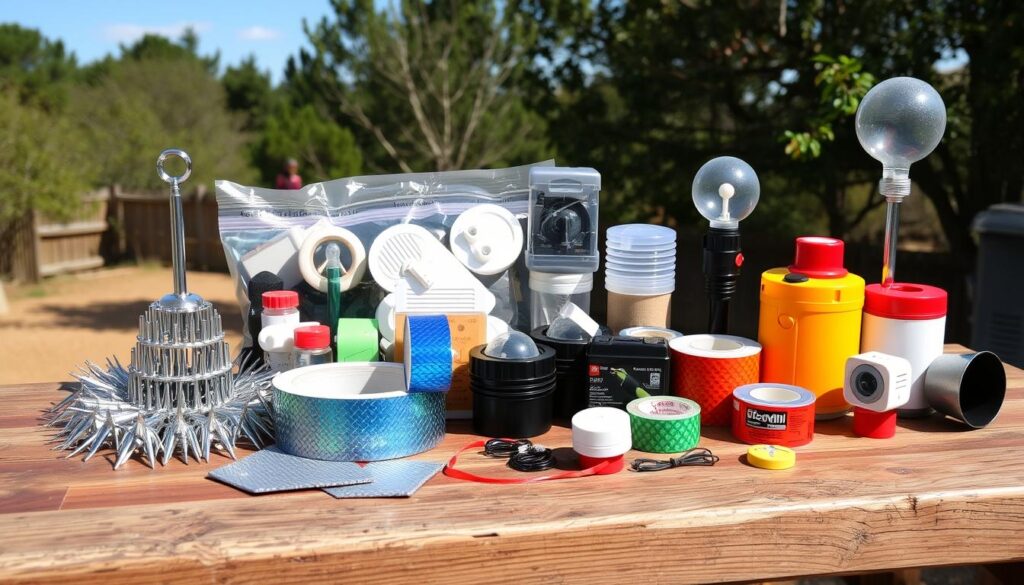
Physical Bird Deterrent Methods
Physical deterrents are great for controlling bird populations. Techniques like bird spikes and netting solutions create barriers. They keep birds away from unwanted areas.
Bird Spikes and Installation
Bird spikes are a top choice for keeping birds off ledges and roofs. They come in stainless steel or plastic. These spikes make a surface birds don’t want to land on.
Installing bird spikes is easy. This makes them a good choice for homes and businesses.
Netting Solutions
Netting is another effective bird deterrent. It’s made from UV-resistant HDPE material. You can use it to cover gardens and balconies.
Netting creates a barrier that keeps birds out. It’s a reliable way to protect your space from birds.
Bird spikes and netting are great for bird-proofing and bird control methods. They help keep birds away from your property.
“Bird exclusion applies in situations where you intend to keep birds away from specific locations.”
| Deterrent Method | Effectiveness | Installation Difficulty | Application |
|---|---|---|---|
| Bird Spikes | High | Easy | Roof, Building, Ledge Protection |
| Netting | High | Moderate | Gardens, Balconies, Building Facades |
| TowerGuard | High | Involved | Protection from Large Birds |
| Daddi Long Legs | High | Easy | Open or Hard-to-Protect Areas |
| Gridwire | High | Moderate | Large Commercial Flat Roofs |
Visual Bird Deterrent Strategies
Keeping birds away from your property can be tough. But using visual deterrents can be very effective. These methods use birds’ fear of predators and sudden movements to keep them away.
Bird deterrent scare tape is a popular choice. It shines and flashes, startling birds. Owl decoys also work well. They look like real birds of prey, making smaller birds afraid to stay.
Scare balloons are another great option. They’re big and bright, looking like predators. Birds see them as a threat and stay away. But, you need to move them often to keep birds scared.
Using different visual deterrents together works best. Mix scarecrows, reflective materials, and motion-activated devices. This creates a strong barrier that keeps birds out of your outdoor areas.
| Visual Deterrent | Effectiveness | Advantages | Considerations |
|---|---|---|---|
| Scare Tape | High | Inexpensive, easy to install | Requires regular repositioning |
| Predator Decoys | Moderate to High | Realistic appearance, long-lasting | Placement and orientation are crucial |
| Scare Balloons | High | Visually striking, versatile placement | Need to be regularly moved or replaced |
| Scarecrows | Moderate | Low-cost, customizable | Require frequent relocation |
Using these visual deterrents can keep birds away from your outdoor spaces. This makes your property bird-free and reduces risks from bird droppings and other problems.
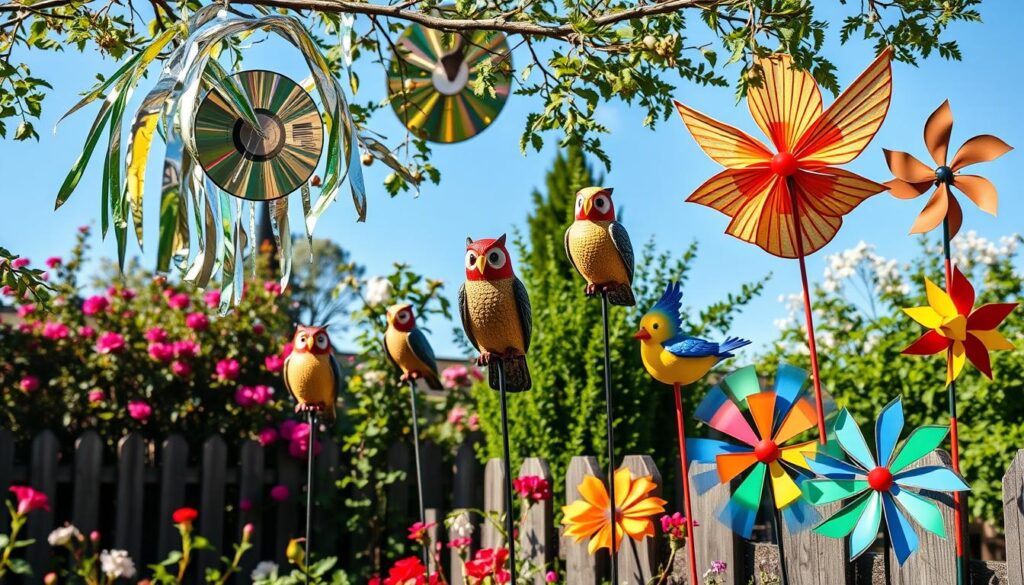
Sound-Based Bird Control Methods
Sound-based solutions are great for keeping birds away. They use sounds to scare birds off, which is kind to animals and good for the planet.
Ultrasonic Devices
Ultrasonic bird deterrents make high sounds that birds can’t stand but humans can’t hear. They work well inside places like warehouses or barns. This way, birds are kept away without bothering people.
Predator Sound Systems
Electronic bird repellers make sounds that mimic birds in danger. They are good for big outdoor areas like farms or gardens. Birds don’t like these sounds and stay away.
Research shows these sounds can cut bird numbers by up to 80%. This is key because birds cost US farms a lot of money each year. It shows how important it is to keep birds away from crops.
Using sound deterrents with other methods can make bird control even better. They are safe for birds and the environment. This makes them a great choice for managing bird problems.
| Deterrent Method | Effectiveness | Suitable Applications |
|---|---|---|
| Ultrasonic Devices | High-frequency sounds above human hearing range | Indoor settings, such as warehouses or barns |
| Predator Sound Systems | Combination of predator calls and distress sounds | Larger outdoor areas, such as farms, orchards, or gardens |
“Sound deterrents can be a humane and eco-friendly way to deter pest birds without causing harm to the environment.”
Choosing the right bird control method depends on your location and local laws. Sound-based deterrents can help manage bird numbers. This way, you can reduce problems caused by birds.
Environmental Modifications to Deter Birds
To keep birds away, start by changing the environment. Remove food sources and clean up droppings and nesting materials. Also, alter the landscape to make it less appealing. Keeping areas clean where birds nest or roost is key for bird-proofing and bird control methods.
To deter birds, use a few strategies. Get rid of standing water and seal up buildings. Also, trim trees and shrubs to reduce nesting spots. These changes make the area less welcoming to birds, encouraging them to find other places.
- Regularly clean and maintain areas where birds frequently roost or nest
- Remove standing water to eliminate breeding grounds
- Seal entry points to buildings to prevent bird intrusion
- Trim trees and shrubs to reduce nesting opportunities
Changing the environment is a key step in bird-proofing and using effective bird control methods. By making the habitat less bird-friendly, you can discourage their presence. This reduces the need for stronger deterrents.
| Environmental Modification | Effectiveness | Considerations |
|---|---|---|
| Removing food sources | High | Ensures birds cannot find sustenance on-site |
| Cleaning up droppings and nesting materials | Moderate | Prevents birds from being attracted to the area |
| Altering the landscape | High | Makes the environment less suitable for birds to thrive |
By combining these environmental changes, you can make your area less inviting to birds. This reduces the need for more intense bird control methods and supports long-term bird-proofing.
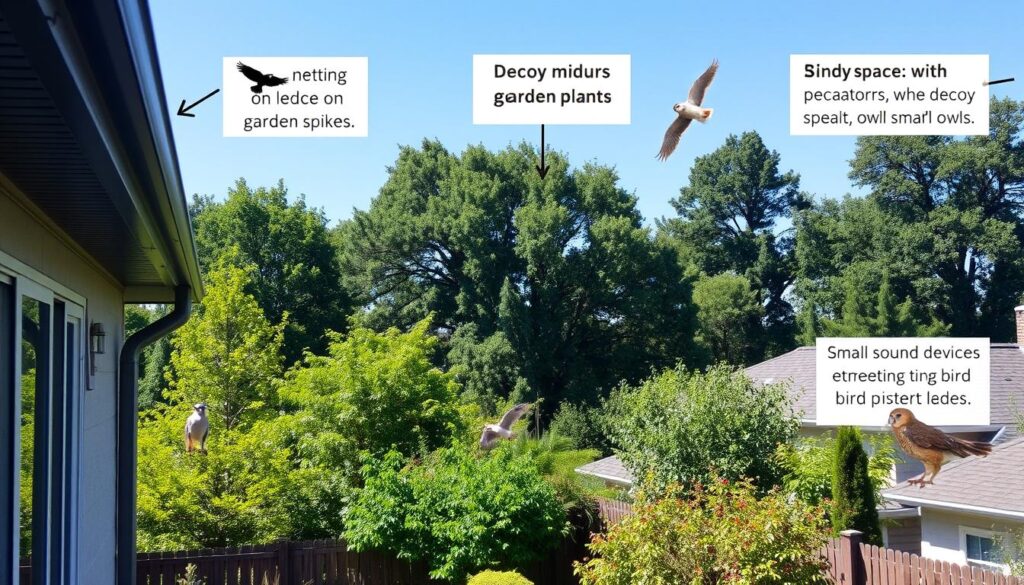
“Exploiting movement with dynamic bird deterrents is more effective than static ones, but the movement should not become predictable to ensure effectiveness.”
Legal Considerations in Bird Control
When trying to keep unwanted birds away, it’s key to know the local laws. Many bird species are protected by laws at both the federal and state levels. Actions that harm these birds can lead to fines or penalties.
Before you start controlling birds, check the local laws. Some deterrents, like toxic chemicals, might be banned in certain areas. Choose humane and eco-friendly methods that follow the law and protect wildlife.
Knowing the laws helps you manage bird issues without breaking them. Talk to local wildlife agencies to learn more. This way, you can keep your place safe while also protecting birds and the environment.
FAQ
What natural methods can be used to deter birds?
To keep birds away, you can use essential oils like peppermint and citrus. Spicy solutions with chili peppers or cayenne also work. Strong-scented herbs like garlic and cinnamon are effective. Vinegar is another option. These smells are unpleasant for birds and keep them away.
How do birds perceive scents and what smells do they dislike?
Birds have a good sense of smell, unlike what many think. They can smell things humans can’t, like citrus and garlic. These smells can scare them away. Birds don’t like strong smells, especially their own droppings and food.
What are some effective essential oil-based bird repellents?
Peppermint oil, citrus oils, and mixes like peppermint and citronella are great for keeping birds away. Mix these oils with water and vinegar to make DIY sprays. Spray these on places where birds like to hang out.
How can spicy solutions be used to deter birds?
Sprays made with cayenne pepper or chili powder can scare birds. The spicy smell bothers their senses but doesn’t hurt them. This makes the area less appealing to birds.
What types of strong-scented herbs can be used to keep birds away?
Garlic, onions, mint, and cinnamon can keep birds away. Make sprays with these herbs and apply them where birds nest or visit. The strong smells are not pleasant for them.
Is vinegar an effective natural bird repellent?
Yes, vinegar, especially apple cider vinegar, can scare birds away. Its strong smell irritates them. Use vinegar sprays on areas like porches and garages to keep birds off.
What are some effective professional bird deterrent products?
Professional products use Methyl Anthranilate (MA), found in concord grapes. MA irritates birds’ noses and throats, keeping them away. Products like Bird-Out use MA in aromatic repellents for long-term protection.
What types of physical bird deterrents are available?
Physical deterrents include bird spikes and bird netting. Bird spikes block birds from landing on ledges and roofs. Bird netting covers areas like gardens or building facades. These solutions last a long time and keep birds away.
How do visual and sound-based bird deterrents work?
Visual deterrents like scare tape and decoys scare birds with sudden movements. Sound-based deterrents, like sonic devices, irritate birds with sounds. But, birds might get used to these over time.
What environmental modifications can help deter birds?
Remove food sources and clean up bird droppings and nests. Change the landscape to be less bird-friendly. Regular maintenance and sealing entry points make areas less appealing to birds.
What legal considerations should be taken when implementing bird control methods?
Many bird species are protected by law. Always check local regulations before using bird control methods. Use only safe, non-toxic products, especially near plants or food. Humane bird control is legal and ethical.
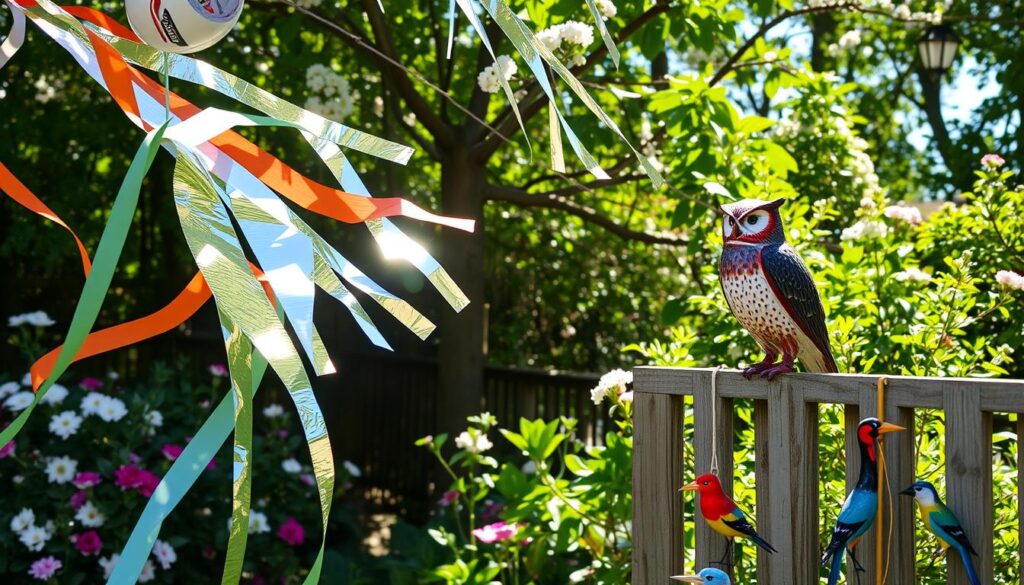

The Real Person!
Author drover sointeru acts as a real person and passed all tests against spambots. Anti-Spam by CleanTalk.
That is very fascinating, You’re an excessively skilled blogger. I’ve joined your feed and stay up for in search of more of your magnificent post. Also, I have shared your site in my social networks!